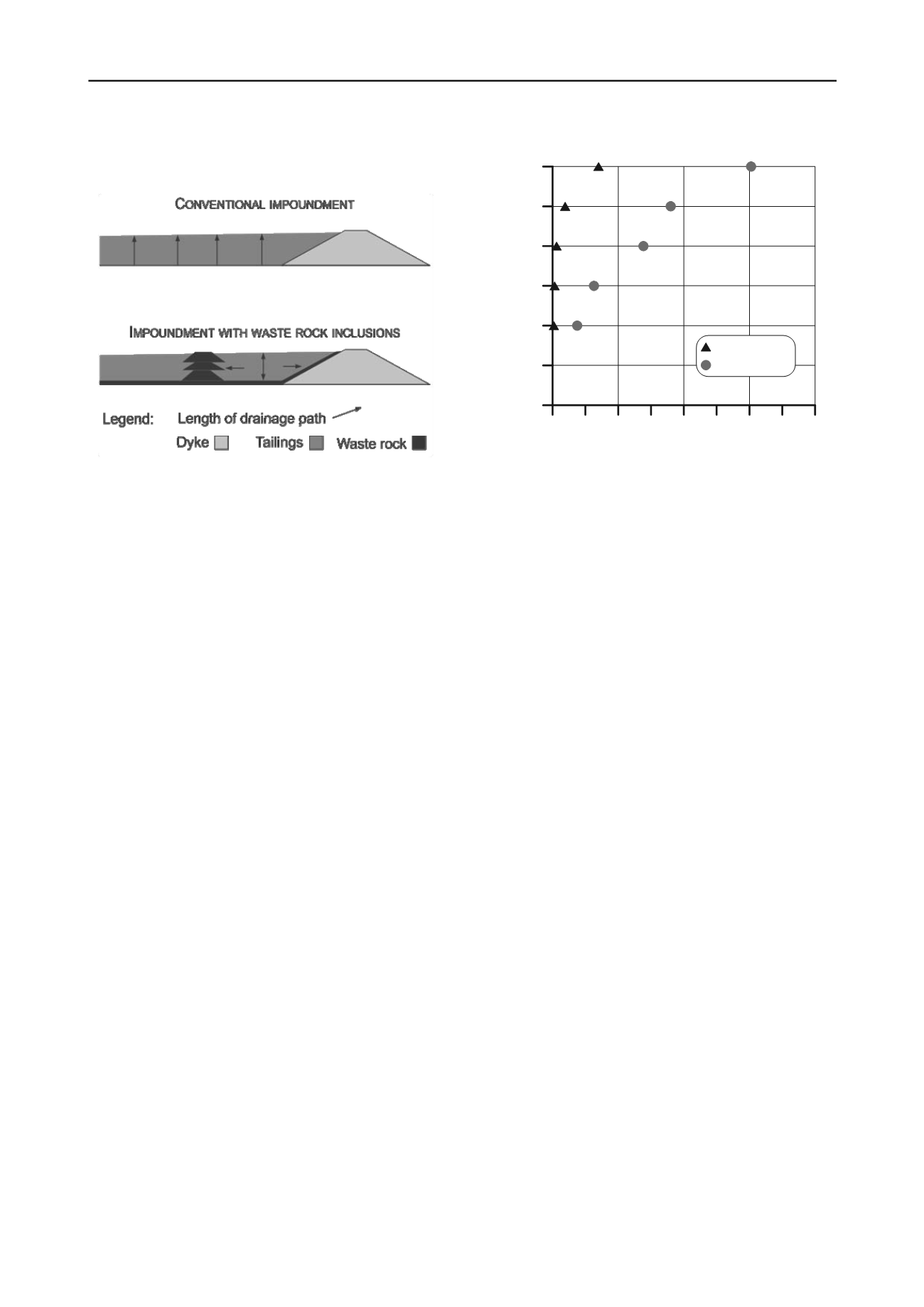
737
Technical Committee 103 /
Comité technique 103
provides adequate bearing capacity for the support of the
successive levels of waste rock.
0
2
4
6
8
Horizontal displacement of the crest (m)
6
6.25
6.5
6.75
7
7.25
7.5
Earthquake magnitude, M w
WRI
Conventional
Rupture
Figure 4. Schematic of the reduced drainage paths for consolidation
with waste rock inclusions.
5 STATIC AND SEISMIC STABILITY
Most tailings impoundment failures are the result of, or lead to,
the liquefaction and flow of tailings. The liquefaction resistance
of tailings increases with consolidation. Therefore, accelerated
consolidation provided by waste rock inclusions reduces the
tendency for liquefaction of the tailings during operations,
particularly when the water table can be lowered below the
tailings surface (producing unsaturated conditions).
James (2009) conducted parametric dynamic numerical
analysis of a 20-m-high, upstream-raised tailings impoundment,
with and without waste rock inclusions. The dynamic loads
were equivalent to the occurrence of earthquakes of moment
magnitude 6.5 to 7.5 with epicentral distances of 30 km from
the site. It was found that the presence of the inclusions
significantly reduced the horizontal deformation of the
impoundment, particularly at the dyke crest. In the case of the
largest magnitude event (7.5), the simulations indicated that the
inclusions prevented rupture of the impoundment. The
horizontal displacement of the crest of the impoundments
obtained from the calculations versus the earthquake
magnitudes are shown on Figure 5. The improved performance
of the impoundment with waste rock inclusions (WRI) is due to
the reinforcing effect of the inclusions. Due to the relatively low
permeability of the tailings, the inclusions did not reduce the
development of excess porewater pressures during shaking,
except in their immediate vicinity.
Tailings impoundments can also fail due to the dissipation of
excess porewater pressure generated during and after
earthquake shaking (Ishihara 1984). With inclusions, these
excess porewater pressures can be dissipated without adversely
affecting the stability of the impoundment (James 2009). The
positive effect of inclusions on excess pore water pressure
development and dissipation was also demonstrated using tests
on a seismic simulator (Pépin et al. 2012).
Figure 5. Horizontal displacements of the crest of a conventional and a
reinforced (WRI) tailings impoundment as a function of earthquake
magnitude (adapted from James 2009).
6 LIMITING THE CONSEQUENCES OF FAILURE
During the dynamic numerical analysis described above, it was
found that the presence of waste rock inclusions significantly
limited the extent of deformation within the impoundment
during shaking. The simulation results also indicated that in the
event of a rupture of the retention dyke, the quantity of tailings
released, and thus the consequences of failure, would be
significantly reduced by the presence of the inclusions. Waste
rock inclusions can thus reduce the risks associated with tailings
impoundment failure.
7 MINE CLOSURE ASPECTS
By accelerating consolidation and compartmentalizing the
tailings, the use of waste rock inclusions can permit faster or
staged closure of the tailings impoundment. For example, a
cover for long-term prevention of AMD can readily be installed
on the surface of consolidated tailings (Bussière 2007).
Consolidation of the tailings during operations will result in less
effluent from the impoundment following closure.
Additionally, waste rock in the tailings impoundment will
not require any closure work in addition to what’s necessary for
the tailings. If all of the waste rock can be placed in the
impoundment (as can be the case for underground mines), there
will be no waste rock piles to reclaim following closure.
8 ONGOING RESEARCH ACTIVITIES
The research activities described above are part of an integrated
research program on the use of waste rock inclusions in tailings
impoundments being conducted by the authors’ group. Other
research activities completed or in progress on this subject are
described below.
In situ testing consisting of piezocone testing and test pit
excavation was completed in the tailings impoundment of
another gold mine in Quebec to characterize the state of the
tailings in situ (James 2009).
Conventional and dynamic testing of tailings was conducted
on tailings samples to evaluate their static and dynamic
properties and behavior. Dynamic testing included cyclic simple
shear (James 2009) and cyclic triaxial tests (Poncelet 2012).
Additional cyclic triaxial testing is in progress.
Parametric numerical modeling studies of the consolidation
of tailings with and without waste rock inclusions were
conducted to establish baseline parameters for the dimensioning
of waste rock inclusions (Jaouhar 2012; Bolduc 2012).
Seismic table testing of tailings with and without inclusions
was conducted to evaluate their behavior under a range of


